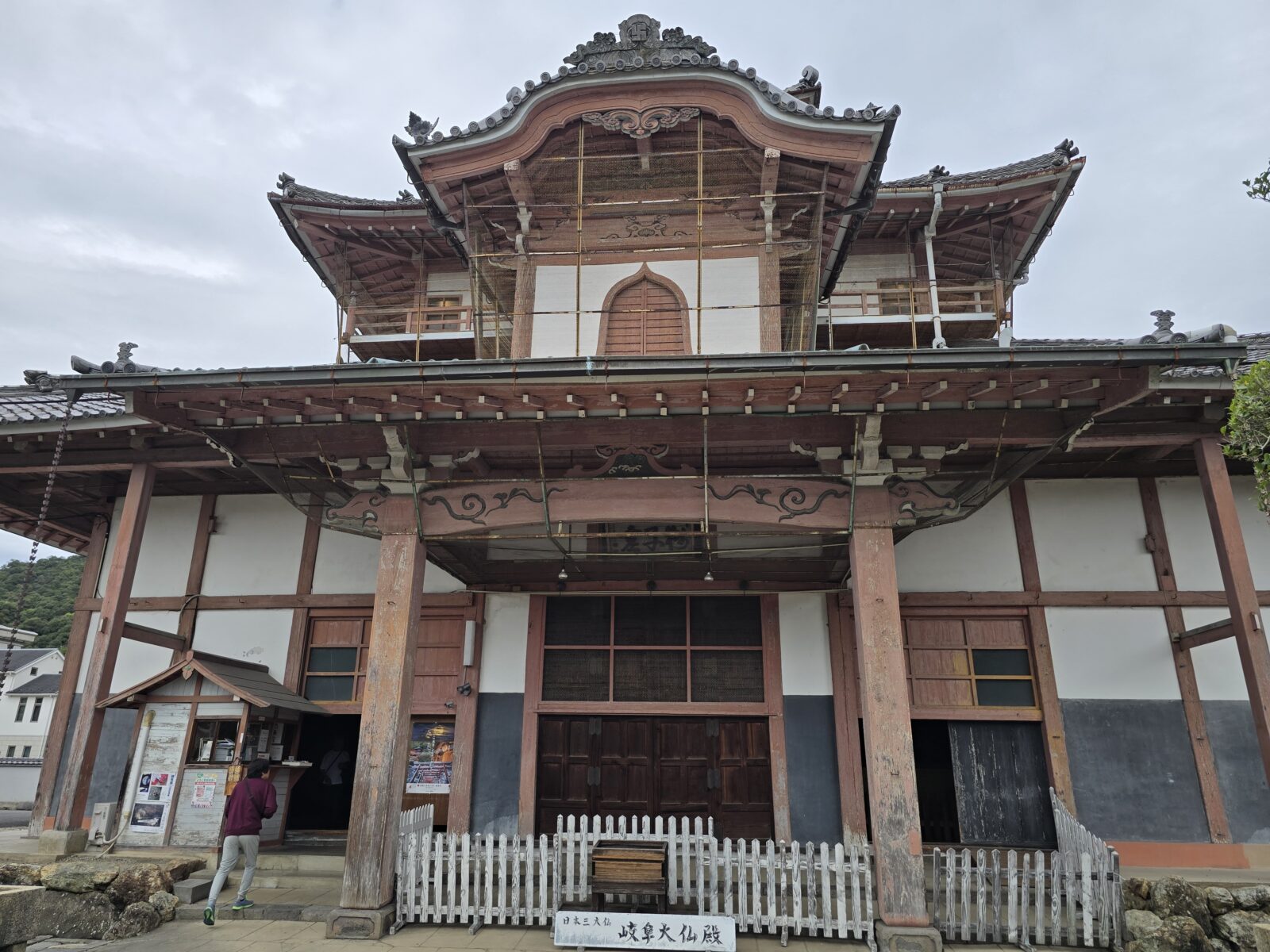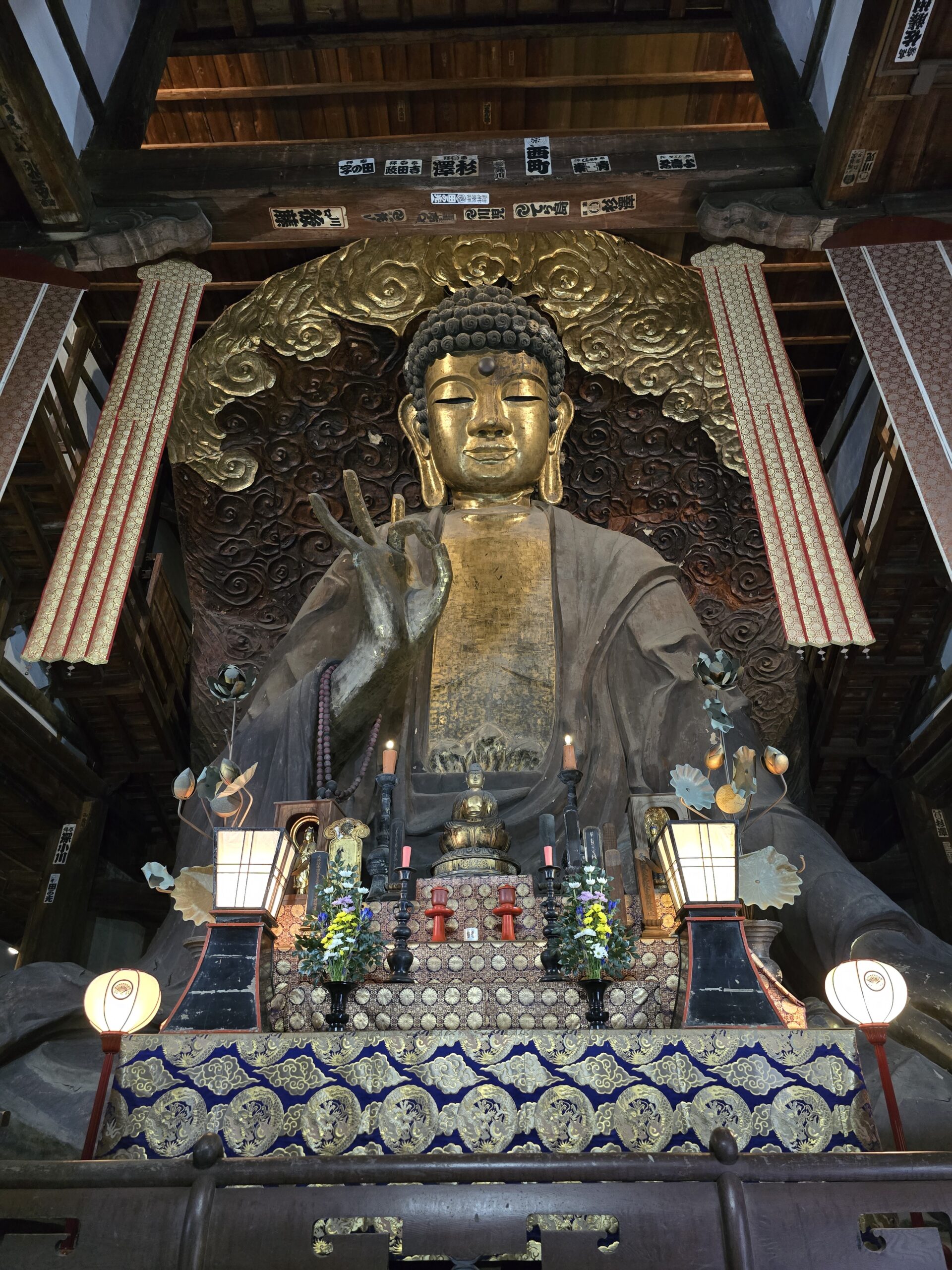(Kinpōzan Shōhō-ji, Daibutsuchō, Gifu City)
When you stroll through the quiet lanes of Daibutsuchō (大仏町) in Gifu City, you might not at first know there’s something extraordinary tucked behind a modest temple gate. But at the heart of the local temple Shōhō‑ji Temple, stands a statue that quietly commands your attention: the great seated Buddha, nearly 14 metres tall, made of bamboo, clay, lacquer and gold leaf.

Why This Buddha Was Built
Shōhō-ji traces its roots to the 17th century. In 1790, the 11th head priest, Priest Ichū, deeply inspired by the grandeur of the Buddha of Tōdai‑ji in Nara, resolved to erect a large statue of Shaka Nyorai in hopes of protecting his community from large earthquakes and famine. gifu-daibutsu.com+2tokyofox.net+2
He began gathering materials, collecting Buddhist sutras (the written scriptures) from across Japan, even walking on foot into remote regions. The method he chose was unusual: rather than carve stone or cast bronze, he opted for a “dry lacquer” technique using bamboo strips, clay, and lacquer coated in gold leaf. This made the statue lighter and built with devotion rather than brute force. hakko-umami.com+1
Sadly, Ichū passed away in 1815 before seeing the project finished. The work then passed to his successor, the 12th-generation head priest, Priest Kōshū, who completed the statue in 1832 — some 38 years from start to finish. VISIT GIFU+1

How It’s Made — Craft and Details
The statue’s construction is remarkable.
- The central pillar is made of ginkgo wood, measuring about 1.8 metres in circumference. KCP International+1
- A framework of different woods built the skeleton; then the body was woven from bamboo strips. Japan Experience+1
- That bamboo structure was covered with clay, then adorned with many Buddhist sutras (paper texts) attached to the surface — the idea being that each scripture becomes a layer of prayer. gifu-daibutsu.com+1
- Finally, the surface was coated repeatedly with lacquer and finished with gold leaf. Wikipedia+1
Here are the specifications often cited:
- Height: 13.63 metres (≈44.7 ft) gifu-daibutsu.com
- Face length: 3.63 metres gifu-daibutsu.com
- Length of ears: 2.12 metres 好運日本行(GOOD LUCK TRIP)+1
- Width of eyes: 0.66 metres gifu-daibutsu.com
- Height of nose: 0.36 metres 好運日本行(GOOD LUCK TRIP)
Many sources list the statue as the largest dry lacquer Buddha in Japan, and count it among Japan’s “Three Great Buddhas” alongside Nara and Kamakura. VISIT GIFU+1
The Temple & Atmosphere
Shōhō-ji is an Ōbaku-school Buddhist temple (a Zen sect with Chinese roots) and a branch of Manpuku‑ji in Uji, Kyoto. Wikipedia
From the outside, the temple building might seem ordinary: a wooden structure, modest gate, and a low profile. But once you step inside the hall and see the golden statue glowing in soft light, the contrast is striking.
The atmosphere is calm, quiet, and reflective. Light plays on gold leaf, the echoes of footsteps matter, and the space invites you to pause. On the white interior walls — flanking the Buddha — lie painted carvings and images of Buddhist deities, adding to the depth of the experience. Japan Experience
Entrance is modest (around ¥200 for adults) and the setting allows you to visit without the rush of major tourist crowds — perfect for a peaceful stop in Gifu. VISIT GIFU+1
Connecting With Gifu’s Other Sights
If you’re exploring Gifu — maybe heading up to the ropeway to Gifu Castle on Mount Kinka — then Shōhō-ji is an excellent complement. It’s only about a 10-minute walk from the castle base station, so you can merge it naturally into your day. Visitors often combine the two: strength and view above, calm and gold inside. hakko-umami.com
Visiting Information & Tips
- Address: 8 Daibutsuchō, Gifu City, Gifu Prefecture 500-8018 Japan Travel+1
- Hours: 9:00-17:00 (may vary by season) hakko-umami.com
- Admission: Adults ~¥200, Children ~¥100 Japan Experience
- Access: ~10-15 min walk from Gifu Castle ropeway station or local bus stop. VISIT GIFU
- Photography: Allowed — just be respectful of the sacred setting and avoid flash if asked.
- Best time to visit: Morning or late afternoon when light softly hits the gold surface; less crowd.
- Nearby: Bring time for Gifu Castle, the park, and local cafés for a full “Gifu Days” experience.

